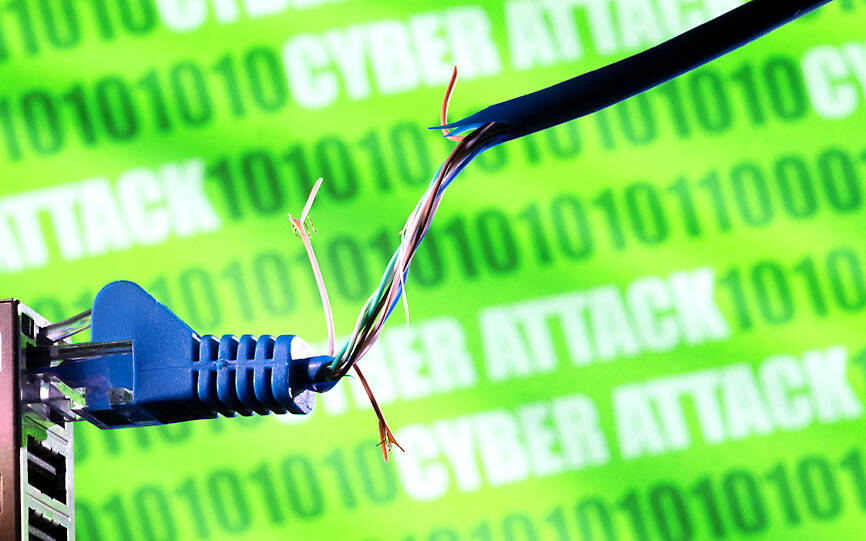An academic has renewed a call for Minister of Digital Affairs Audrey Tang (唐鳳) to identify China in proposed amendments to the Cyber Security Management Act (資通安全管理法) in a Facebook duel over public policy.
A draft of the amendments released by the Ministry of Digital Affairs stipulated that government offices would be barred from using devices or software deemed to be a cybersecurity risk or employing the services of a contractor or venue that uses such products.
In a Facebook post on Thursday, National Cheng Kung University electronics engineering professor Lee Chung-hsien (李忠憲) said that the proposed amendment should explicitly ban government offices from using hardware or software originating from China.

Photo: Reuters
Tang later that day defended the policy through an intermediary, saying that forbidding officials from using any Beijing-controlled technology without regard to the listed country of origin was among her first acts in office.
Information security is a top priority for the ministry, which continues to spearhead Taiwan’s participation in the Global Tech Security Commission to bolster the nation’s ability to defend data security in conjunction with foreign partners, she was paraphrased as saying.
In a post on Friday, Lee asked why the ministry does not clearly state that the restricted products include those made in China.
Asked to elaborate, Lee said he believes that a national cybersecurity policy must unambiguously name the main security threat it seeks to address.
Priorities cannot be assigned or resources properly allocated if the threat is never identified by name, he said.
As no absolutes exist in security, regulators must prioritize threats, he said, adding that the terms used in the draft were too vague and might confuse officials tasked with implementing security measures.
Fears of a blowback from China over the amendments are overblown, as the scope of the legislation is limited to protecting government offices and key infrastructure, Lee added.
“Refusing to prepare our defenses, buy weapons or treat China as an enemy would not make Taiwan safer,” he said.
“The government has to punish rule-breakers with heavy fines and invest real resources in patching up vulnerabilities to make clear that cybersecurity is not just for show,” he said.

Taiwanese scientists have engineered plants that can capture about 50 percent more carbon dioxide and produce more than twice as many seeds as unmodified plants, a breakthrough they hope could one day help mitigate global warming and grow more food staples such as rice. If applied to major food crops, the new system could cut carbon emissions and raise yields “without additional equipment or labor costs,” Academia Sinica researcher and lead author the study Lu Kuan-jen (呂冠箴) said. Academia Sinica president James Liao (廖俊智) said that as humans emit 9.6 billion tonnes of carbon dioxide compared with the 220 billion tonnes absorbed

The Taipei Mass Rapid Transit (MRT) Wanda-Zhonghe Line is 81.7 percent complete, with public opening targeted for the end of 2027, New Taipei City Mayor Hou You-yi (侯友宜) said today. Surrounding roads are to be open to the public by the end of next year, Hou said during an inspection of construction progress. The 9.5km line, featuring nine underground stations and one depot, is expected to connect Chiang Kai-shek Memorial Hall Station to Chukuang Station in New Taipei City’s Jhonghe District (中和). All 18 tunnels for the line are complete, while the main structures of the stations and depot are mostly finished, he

Taipei is to implement widespread road closures around Taipei 101 on Friday to make way for large crowds during the Double Ten National Day celebration, the Taipei Department of Transportation said. A four-minute fireworks display is to be launched from the skyscraper, along with a performance by 500 drones flying in formation above the nearby Nanshan A21 site, starting at 10pm. Vehicle restrictions would occur in phases, they said. From 5pm to 9pm, inner lanes of Songshou Road between Taipei City Hall and Taipei 101 are to be closed, with only the outer lanes remaining open. Between 9pm and 9:40pm, the section is

China’s plan to deploy a new hypersonic ballistic missile at a Chinese People’s Liberation Army Rocket Force (PLARF) base near Taiwan likely targets US airbases and ships in the western Pacific, but it would also present new threats to Taiwan, defense experts said. The New York Times — citing a US Department of Defense report from last year on China’s military power — on Monday reported in an article titled “The missiles threatening Taiwan” that China has stockpiled 3,500 missiles, 1.5 times more than four years earlier. Although it is unclear how many of those missiles were targeting Taiwan, the newspaper reported